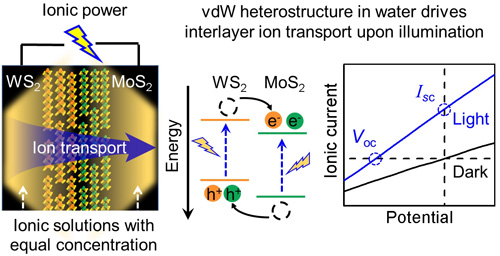| Mar 04, 2021 | |
van der Waals heterostructures harness ionic power from photo-induced ion transport |
|
| (Nanowerk Spotlight) Ionic power is ubiquitous in physiological or environmental waters, and it is generally considered as a sustainable, yet largely untapped energy resource that catches the eye of scientists. | |
| Recent advances in low-power electronics for personalized diagnostics and medical care also put forward grand demand for small-scale energy components that are capable of extracting ambient energy on the order of µW to mW for real-time health assessment, as alternatives to replaceable batteries. | |
| In natural or synthetic systems, ion transport under nanoscale confinement plays a crucial role, and it is fundamentally involved in a broad range of disciplines, such as bio-inspired materials, electrochemistry, chemical analysis, and membrane-based technologies. | |
| In general, there are three types of driving force for ion transport: electric field; mechanical pressure; and concentration gradient. | |
| Ion transport under these electrokinetic driving forces is widely studied by many research groups. In recent years, light has been newly proposed as the fourth type of driving force for remote, non-invasive, and active control of molecular and ionic transport in man-made materials (see our previous Nanowerk Spotlight: "Light-induced active ion transport in graphene oxide membranes"). | |
| Towards the next-generation light-to-ionic energy conversion, van der Waals heterostructures, composed of two or more types of restacked 2D materials, show fascinating optoelectronic characteristics. These materials have become a source of inspiration, which would enable efficient electron-hole separation in the layered constituents and give rise to new driving mechanisms for ion transport inbetween the atomic layers. | |
| "In this context, we report, for the first time, the incorporation of a transition metal dichalcogenides (TMDs) based van der Waals multilayer heterostructure into nanofluidic materials and demonstrate a new photo-induced active ion transport phenomenon therein," Professor Wei Guo from the Technical Institute of Physics and Chemistry, Chinese Academy of Sciences, in Beijing, tells Nanowerk. | |
| Guo and his collaborators reported their findings in Advanced Materials, "Harnessing Ionic Power from Equilibrium Electrolyte Solution via Photoinduced Active Ion Transport through van-der-Waals-Like Heterostructures". | |
| Taking WS2/MoS2 heterostructures for example, upon visible light illumination, a net ionic flow is generated through the Janus TMD membrane without assist of any extra driving force, suggesting a directional cationic transport from WS2 to MoS2. | |
| The researchers explain the transport mechanism in terms of a photovoltaic effect due to type II band alignment of the WS2/MoS2 heterostructures, in which the conduction band minimum is present in MoS2, while the valence band maximum stayed in WS2 (see figure below). | |
 |
|
| Transition metal dichalcogenide based van der Waals multilayer heterostructures are used to harvest ionic power from equilibrium electrolyte solutions via a coupled photon-carrier–ion transport mechanism due to type II band alignment. (Source: Prof. Wei Guo, Technical Institute of Physics and Chemistry, Chinese Academy of Sciences, Beijing) (click on image to enlarge) | |
| Under illumination, the excited electrons in WS2 jump to the MoS2 layers, and the holes generated in MoS2 transfer to the WS2 layers. | |
| This dual process facilitates an efficient charge separation between the two parts and consequently establishes a photovoltaic driving force for interlayer ion transport. | |
| The generation of net ionic transport by light can be considered as a new type of asymmetric transport property in one-dimensional (1D) and two-dimensional (2D) nanofluidic systems (Accounts of Chemical Research, "Asymmetric Ion Transport through Ion-Channel-Mimetic Solid-State Nanopores"). | |
| In equilibrium electrolyte solutions, this effect can be used for harvesting ionic power. The maximum ionic photoresponse reaches ∼21 µA/cm2 and ∼45 mV, respectively, under one sun equivalent excitation. Under optimized condition, the harvested power density is nearly 2 mW/m2. | |
| The researchers point out that harvesting ionic power in equilibrium electrolyte solution is completely different from existing ionic gradient power generation. "The ionic photovoltaic response purely reflects a light-induced motive force for ion transport, rather than an artificially established liquid-junction potential difference," says Guo. | |
| He concludes: "Therefore, the proof-of-concept demonstration of photonic-to-ionic power generation with van-der-Waals-like nanofluidic heterostructures will inspire a broad range of fundamental research and practical application for light-controlled ionic circuits, artificial photosynthesis, biomimetic energy conversion, and so on." | |
 By
Michael
Berger
– Michael is author of three books by the Royal Society of Chemistry:
Nano-Society: Pushing the Boundaries of Technology,
Nanotechnology: The Future is Tiny, and
Nanoengineering: The Skills and Tools Making Technology Invisible
Copyright ©
Nanowerk LLC
By
Michael
Berger
– Michael is author of three books by the Royal Society of Chemistry:
Nano-Society: Pushing the Boundaries of Technology,
Nanotechnology: The Future is Tiny, and
Nanoengineering: The Skills and Tools Making Technology Invisible
Copyright ©
Nanowerk LLC
|
|
|
Become a Spotlight guest author! Join our large and growing group of guest contributors. Have you just published a scientific paper or have other exciting developments to share with the nanotechnology community? Here is how to publish on nanowerk.com. |
|
